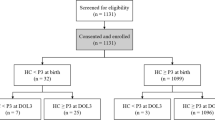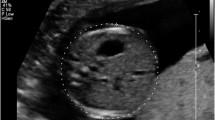Abstract
Purpose
To evaluate which reference curve (RC)—Snijders, Intergrowth 21st (IG21) and World Health Organization (WHO)—is more accurate for microcephaly diagnosis.
Methods
Retrospective cohort study with more than 30,000 exams in more than 11,000 women. Microcephaly was confirmed by a neonatologist at birth and positive predictive values (PPVs) and misdiagnosis were assessed.
Results
A total of 71 cases were confirmed as microcephaly at birth. IG21 and Snijders PPVs showed to be more significant over WHO’s (p < 0.001), without difference between them (p = 0.39). All RC were superimposed and did not show significant difference. When evaluated in different fragments, three trends were observed (until 30 weeks, between 30 and 36 and after 36 weeks of gestational age), with the latter interval showing a significant difference between IG21 and WHO (p = 0.0079). Conversely, WHO exhibited only one misdiagnosis, a much lower rate than Snijders, who missed eight cases and IG21, nine.
Conclusion
WHO’s RC appears to misdiagnose fewer cases, which could be useful for a population screening, while IG21’s RC presented a more significant PPV, being more useful for a more precise final diagnosis in reference centers.



Similar content being viewed by others
Change history
05 November 2020
In the original article published, the name of the corresponding author is incorrect. The correct name is Lucas Trigo.
References
Johnsen SL, Rasmussen S, Wilsgaard T, Sollien R, Kiserud T, Lian Johnsen S (2006) Longitudinal reference ranges for estimated fetal weight. Acta Obstet Gynecol Scand 85(3):286–297
Kiserud T, Johnsen SL (2009) Biometric assessment. Best Pract Res Clin Obstet Gynaecol 23(6):819–31
Chervenak FA, Jeanty P, Cantraine F et al (1984) The diagnosis of fetal microcephaly. Am J Obstet Gynecol 149(5):512–517
Smith PA, Chudleigh P, Campbell S (1984) Prenatal diagnosis. Ultrasound Br J Hosp Med. 31:421–426
Pante FR, Madi JM, de Araújo BF, Zatti H, Madi SRC, Rombaldi RL (2011) Malformações congênitas do sistema nervoso central: prevalência e impacto perinatal. AMRIGS 55(4):339–344
Sakkas H, Economou V, Papadopoulou C (2016) Zika virus infection: past and present of another emerging vector-borne disease. J Vect Borne Dis 53:305–311
Neu N, Duchon J, Zachariah P (2015) TORCH infections. Clin Perinatol 42(1):77–103
Graham KA, Fox DJ, Talati A et al (2017) Prevalence and clinical attributes of congenital microcephaly—New York, 2013–2015. MMWR 66(5):125–129
Rawlinson WD, Boppana SB, Fowler KB et al (2017) Congenital cytomegalovirus infection in pregnancy and the neonate: consensus recommendations for prevention, diagnosis, and therapy. Lancet Infect Dis 17:e177–e188
Delgado Peña YP, Rodríguez Martínez G, Samper Villagrasa MP et al (2012) Características socioculturales, obstétricas y antropométricas de los recién nacidos hijos de madre fumadora. An Pediatr (Barc) 76(1):4–9
Ortega-Garcia JA, Gutierrez-Churango JE, Sanchez-Sauco MF et al (2012) Head circumference at birth and exposure to tobacco, alcohol and illegal drugs during early pregnancy. Childs Nerv Syst 28(3):433–439
del Campo M (2017) A review of the physical features of the fetal alcohol spectrum disorders. Eur J Med Genet 60(1):55–64
Kagan KO, Sonek J, Wagner P, Hoopmann M (2017) Principles of first trimester screening in the age of non-invasive prenatal diagnosis: screening for chromosomal abnormalities. Arch Gynecol Obstet 296(4):645–651
Santorum M, Wright D, Syngelaki A, Karagioti N, Nicolaides KH (2017) Accuracy of first-trimester combined test in screening for trisomies 21, 18 and 13. Ultrasound Obstet Gynecol 49(6):714–720
Gordijn SJ, Beune IM, Thilaganathan B et al (2016) Consensus definition of fetal growth restriction: a Delphi procedure. Ultrasound Obstet Gynecol 48(3):333–339
Figueras F, Gratacos E (2017) An integrated approach to fetal growth restriction. Best Pract Res Clin Obstet Gynaecol 38:48–58
Snijders RJM, Nicolaides KH (1994) Fetal biometry at 14–40 weeks’ gestation. Ultrasound Obstet Gynecol 4(1):34–48
WHO Multicentre Growth Reference Study Group (2006) WHO Child Growth Standards based on length/height, weight and age. Acta Paediatr Suppl 450:76–85
Juliusson PB, Roelants M, Hoppenbrouwers K, Hauspie R, Bjerknes R (2011) Growth of Belgian and Norwegian children compared to the WHO growth standards: prevalence below -2 and above +2 SD and the effect of breastfeeding. Arch Dis Child 96(10):916–921
Natale V, Rajagopalan A (2014) Worldwide variation in human growth and the World Health Organization growth standards: a systematic review. BMJ Open 4(1):e003735
Buck Louis GM, Grewal J, Albert PS et al (2015) Racial/ethnic standards for fetal growth: the NICHD fetal growth studies. Am J Obstet Gynecol 213(4):449.e1–449.e41
Altman DG, Ohuma EO, International Fetal and Newborn Growth Consortium for the 21st Century (2013) Statistical considerations for the development of prescriptive fetal and newborn growth standards in the INTERGROWTH-21st Project. BJOG 120(Suppl. 2):71–6
Papageorghiou AT, Ohuma EO, Altman DG et al (2014) International Fetal and Newborn Growth Consortium for the 21st Century (INTERGROWTH-21st). International standards for fetal growth based on serial ultrasound measurements: the Fetal Growth Longitudinal Study of the INTERGROWTH-21 st Project. Lancet 384:869–879
Leibovitz Z, Daniel-Spiegel E, Malinger G et al (2016) Prediction of microcephaly at birth using three reference ranges for fetal head circumference: can we improve prenatal diagnosis? Ultrasound Obstet Gynecol 47(5):586–592
Stirnemann JJ, Fries N, Bessis R, Fontanges M, Mangione R, Salomon LJ (2017) Implementing the INTERGROWTH-21st fetal growth standards in France: a ”flash study” of the College Français d’Echographie Foetale (CFEF). Ultrasound Obstet Gynecol 49(4):487–492
Kiserud T, Piaggio G, Carroli G et al (2017) The World Health Organization fetal growth charts: a multinational longitudinal study of ultrasound biometric measurements and estimated fetal weight. PLOS Med 14(1):e1002220
Kiserud T, Piaggio G, Carroli G et al (2017) Correction: The World Health Organization fetal growth charts: a multinational longitudinal study of ultrasound biometric measurements and estimated fetal weight. PLOS Med 14(3):e1002284
American Institute of Ultrasound in Medicine (2013) AIUM practice parameter for the performance of obstetric ultrasound examinations. Laurel, USA
Committee on Obstetric Pratice, the American Institue of Ultrasound in Medicine, and the Society for Maternal-Fetal Medicine (2017) Methods for estimating the due date. Committee opinion no. 700. Obstet Gynecol 129(5):e150–e154
Villar J, Cheikh Ismail L, Victora CG, International Fetal and Newborn Growth Consortium for the 21st Century (INTERGROWTH-21st), et al (2014) International standards for newborn weight, length, and head circumference by gestational age and sex: the Newborn Cross-Sectional Study of the INTERGROWTH-21st Project. Lancet 384(9946):857–868
Villar J, Giuliani F, Bhutta ZA, Bertino E, International Fetal and Newborn Growth Consortium for the 21(st) Century (INTERGROWTH-21(st) et al (2015) Postnatal growth standards for preterm infants: the Preterm Postnatal Follow-up Study of the INTERGROWTH-21st Project. Lancet Glob Health 3(11):e681–e691
Intergrowth 21st. Intergrowth 21st standards and tools. https://intergrowth21.tghn.org/standards-tools/.
Leisenring W, Alonzo T, Pepe MS (2000) Comparisons of predictive values of binary medical diagnostic tests for paired designs. Biometrics 56(2):345–351
Bonferroni CE (1936) Teoria statistica delle classi e calcolo delle probabilità. R Ist Super di Sci Econ e Commer di Firenze 8:3–62
Cheng YKY, Lu J, Leung TY, Chan YM, Sahota DS (2018) Prospective assessment of the INTERGROWTH-21 and WHO estimated fetal weight reference curve. Ultrasound Obstet Gynecol 51(6):792–798
Funding
The first author received a Master of Sciences scholarship from Coordination for the Improvement of Higher Education Personnel (CAPES).
Author information
Authors and Affiliations
Contributions
LT, EA: Protocol/project development, data collection or management, data analysis, manuscript writing/editing. JRB, STM: Project development, data collection or management. LGB: Data management, data analysis, manuscript writing/editing.
Corresponding author
Ethics declarations
Conflict of interest
The authors declare that they have no conflict of interest.
Ethical approval
This study was performed in accordance with the 1964 Helsinki Declaration and received Institutional Board Review for being performed.
Informed consent
Informed consent was not required as it was a retrospective study and all information were de-identified.
Additional information
Publisher's Note
Springer Nature remains neutral with regard to jurisdictional claims in published maps and institutional affiliations.
Rights and permissions
About this article
Cite this article
Monteiro de Castro Doin Trigo, L.A., Benini-Junior, J.R., Brito, L.G.O. et al. Ultrasound diagnosis of microcephaly: a comparison of three reference curves and postnatal diagnosis. Arch Gynecol Obstet 300, 1211–1219 (2019). https://doi.org/10.1007/s00404-019-05234-5
Received:
Accepted:
Published:
Issue Date:
DOI: https://doi.org/10.1007/s00404-019-05234-5




